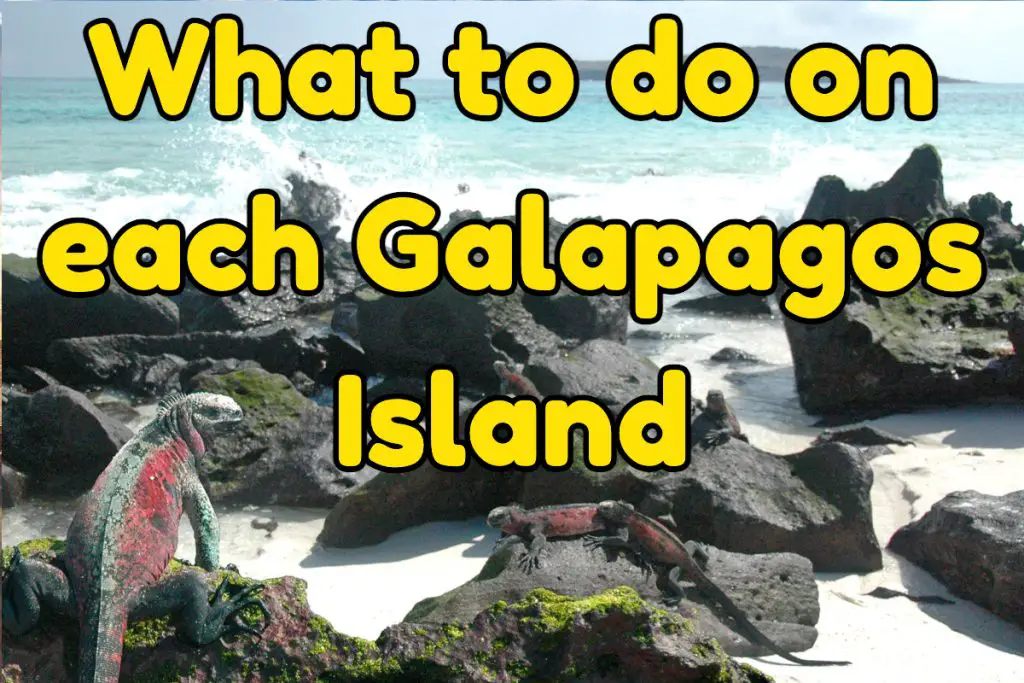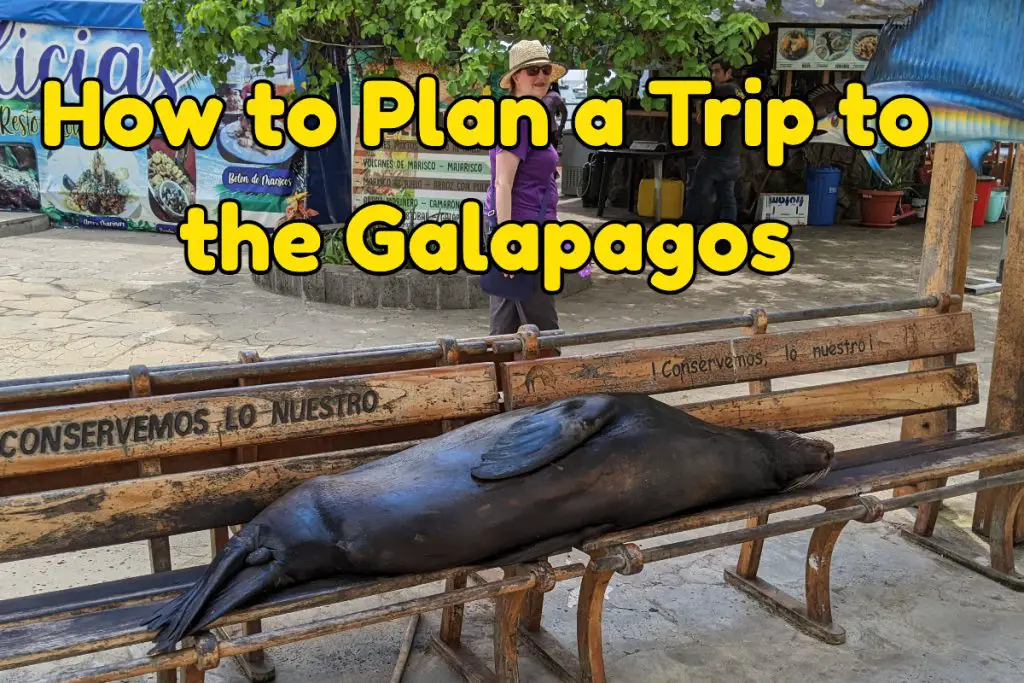
What to do in Bartolomé Island, Galapagos
The most famous thing to see on this island is Pinnacle Rock, a neat rock formation that defines the look of this island. In addition, there is lava formations both above and below the water, a great panoramic view after a short hike to the top of Pinnacle point, and great opportunities to see Penguins, pioneer plants, lava cactus; snorkeling: reef sharks, rays, and great colorful fish.
What to do in Darwin Island, Galapagos
Scuba dive. This is where you can scuba down and look up to see hundreds of circling hammer head sharks.
What to do in Española Island, Galapagos
Gardiner Bay
Here you’ll find white sand beaches, a pack of sea lions hanging out on the beach and the highlight of the area the waved albotross. This island is home to about 10,000 of them.
Osborn Islet
This is a small island ideal for a little swimming and snorkeling.
Suarez Point
Here you can see albatrosses launching themselves, safely, off of a cliff. With a mostly easy hike you will walk alongside many birds such as the Nazca Boobies, Galapagos Hawk and blue footed boobies. One of the highlights of this area is what appears to be a blowhole. As the waves crash into the shores, there is an area where the water spouts up into the air. It is really fun to watch the blowhole among that many many many birds that hang out near it.
What to do in Fernandina Island, Galapagos
Espinosa Point
Here you can see the flightless Comorant (bird) and marine iguanas with the backdrop of an active volcano! If that doesn’t satisfy you then you may also see the Galapagos Hawk, pengions, sea lions and the amazing landscape of this small area.
Mangle Point
Penguins, sea lions and great snorkeling opportunities are here.
Cape Douglas
Penguins, sea lions and great snorkeling opportunities are here. Yes, most of this island offer the same creatures to see, just from a different perspective.
What to do in Floreana Island, Galapagos
Post Office Bay
This is the only post office in the world where you drop a letter off and without payment, someone else picks it up and hand delivers it to the destination. Even better, you can pick up some mail local to your home and deliver someone else’s mail! It’s fun in theory, we hand delivered the pieces of mail to apartments in our city but the letters that we received were dropped off with our doorman because we weren’t home.
Baroness viewing point
There is an interesting story about a baroness and her multiple lovers here alongside a very interesting view. This location has easy hikes where you can see interesting local fauna.
Champion Islet
Just off of Floreana Island this is considered one of the more gorgeous spots in the Galapagos with great snorkeling and scuba diving opportunities.
Devil’s Crown
This is one of the major snorkeling highlights in the Galapagos where you can see sharks, rays, excellent underwater geology and lots of tropical fish.
Cormorant Point
This area is a lagoon where you can see flamingos and a green colored beach.
Asilo de la Paz
Most tours don’t go here. This location is a hike into the island of historical significance. There are caves, where some of the first human settlers of the Galapagos lived among the forrest of trees, a fresh water spring, and corralled giant tortoises.
What to do in Genovesa Island, Galapagos
El Barranco/Prince Phillip’s Steps
A steep climb up wooden steps lead to a very rocky terrain and you find yourself in a bird paradise of 200,00 Red-footed boobies and their nesting sites.
Darwin Bay
You like birds? Walk along the mangroves and see the beautiful swallow tailed gulls, nesting red footed boobies, great frigatebirds and the very rare lava gulls.
What to do in Isabela Island, Galapagos
Albemarle Point
Vicente Roca Point
Tagus Cove
Urbina Bay
Elizabeth Bay
Moreno Point
Volcán Cerro Azul
Sierra Negra
Wall of Tears
Wetlands
Tortoise Breeding Center
Las Tintoreras
What to do in North Seymour Island, Galapagos
Great spot to enjoy geologic rock formations as you are surrounded by the open nesting grounds of blue-footed Boobies, Great and magnificent Frigate birds – 2 different species. While they take up lot of space on this island you can also see the rare swallow-tailed Gulls and perhaps underfoot you’ll spot a snake!
What to do in Pinta (Louis) Island, Galapagos
There is only one place to stop off this island – Punta Neros. This is a water only location at the very northernmost point of the island. There is a lot to see here when you go snorkeling including the Red-lipped Batfish, sea lions, sea turtles, pelagic fish species, tropical fish and Moray Eels.
What to do in Rábida Island, Galapagos
This is the west most island, the only island that is west of the giant Isabella Island. It has great snorkeling and red beaches
What to do in Santiago Island, Galapagos
Buccaneer Cove
This location has some history to it. When pirates visited these islands to stock up on meat and repair their ships they would hang out here. What makes it special today is that there are tons and tons of birds perched at the top of the cliffs often diving head first into the water to get something to eat. There is also a small but worthwhile visit to a red sand beach.
James Bay / Egas Port
One location with two different names. Here you can see Galapagos Hawks and Galapagos Lava Lizards. With the easy hike you can see baby fur seals playing in the shallow waters of tidal pools. There is good snorkeling opportunities here as well.
Albany Islet
This is a scuba dive spot where there are plenty of little areas to explore under water each offering a different opportunity to see unique sea creatures,.
Chinese Hat
They try to make a big deal out of how this island looks like a Chinese hat but if you ignore that it is still a great place to see interesting geological formations like lava tubes and lava flows and there is also great snorkeling off of the white sandy beach.
Espumilla Beach
one word. Snorkeling. This beach is an interesting area to snorkel as there is an ongoing chase going on. Crabs are being hunted by herons and underwater you can see octopus, moray eels, and sharks.
Sullivan Bay
This area has a recent lava flow about 100 years ago. It is amazing to understand that the life that we see there now did not live there for generations. If you are into geology, this needs to be on your list as the recent lava flows mean that the landscapes are pretty unique.
Cousins Rocks
This is a scuba diving location. There is a lot to see here manta rays, Galapagos sharks, sea horses, sea turtles and coral are some examples.
What to do in Santa Cruz Island, Galapagos
Charles Darwin Station / Fausto Llerena Breeding Center
These two locations are very close to one another so if you do one, you might as well do them both. This requires getting on land near a town so you will go to these locations then have a little time to explore the town. The town is basic but nice enough for a few hours. These two locations provide you with information on the giant turtles of the Galapagos along with the ability to see wild turtles that inhabit this region. It is a interesting place to learn about them and one highlight is that they actually have wifi for you to upload your photos.
Garrapatero Beach
This is a pretty beach to relax on with lot’s of possible animal sightings like flamingos, marine iguanas, lava lizards, lava gulls, yellow warblers, and brown pelicans, among other wildlife. What you see depends on how lucky you get.
Lava Tunnels
These lava tunnels are HUGE. It is cave-like an area that you can hike, crawl and climb through while you learn about the geology of the island and of course the lava tubes that you find yourself standing in.
Tortuga Bay
This long stretch of white sand beach is named “Tortuga” (Turtle) because of the black sea turtles that nest here. Overall, this is beach visit is a classical beach trip. You can relax on the beach, swim in the ocean or build sand castles. There’s not much else going on here.
Whale Bay
You will not see whales here, instead this bay is named after the whalers who used to stop in this location. It has a difficult hike with a green sand beach and the ability to see sea lions, marine iguanas, blue-footed boobies, frigate birds and Galapagos hawks.
Gordon’s Rock
This is a scuba diving spot located in the inside of a volcanic crater! There are very strong currents here but for those adventurous ones you can see hammerhead sharks, sting rays, manta rays, turtles and moray eels.
Bachas Beach
The highlight of a visit to Bachas Beach is that there are two bodies of water that host bright pink Flamingos with the possibility to see iguanas, coastal birds, Darwin finches, mockingbirds, and gulls
Black Turtle Cove
In this location you do not get off of the boat. However you can see 4 species of mangroves and just below the water you’ll see White-tipped reef sharks and rays.
Cerro Mesa
This is an ideal location if you want to go biking or hiking. You’ll mostly come across flamingos and Iguanas.
Dragon Hill
A small hike and you will see flamingos and iguanas with the singing mockingbirds, Darwin finches, yellow warblers and Galapagos doves.
Eden Islet
While there is no landing place on this island, but you will see a ton of birds and iguanas as you circle around it in your boat. The snorkeling opportunities are rich here with the ability to see rays, green turtles and sharks. If you enjoy geology then you should research volcanic tuff cone before you go.
Highlands
This area is a place to hike. You will see giant tortoises living in their natural habitat, lush vegetation and excellent photo opportunities
Twin Craters
These “craters” are actually areas where hot magma has caused a collapse of the environment around it, but they do look like craters. This location offers a interesting hike around the craters with a great view over the lush landscape. You will also walk through a forrest filled with birds such as the Galápagos Doves, Darwin’s Finches, the stunning Vermilion Flycatcher, as well as short-eared owls.
What to do in Santa Fe Island, Galapagos
This is one of the most sheltered places in the Galapagos. There is a turquoise lagoon, which used to be used as a landing point. Here you can see frigate birds, blue footed boobies, sea lions, marine iguanas, swallow-tailed gulls, snakes, herons, hawks, sharks, rays, Darwin’s finches and land iguanas. A giant host of varied animals for you to enjoy,
What to do off San Cristobal, Galapagos
Kicker Rock
Boats do not land on or stop at Kicker Rock, so when you get into the water it is certainly a wet landing. It is a small island off of San Cristobal where there are amazing rock formations jutting out of the water into the sky with fabulous frigate birds, nazca boobies and blue footer boobies abound. In the water you can see sea turtles, marine iguanas, rays, Galapagos sharks, tropical fish.
Lobos Island
Lobos quite literally means sea lions and this island is full of them. There are two main activities here, the first is to walk on the island among the many sea lions that grace the land along with frigate birds and blue footed boobies. The second is to go snorkeling along the edge of the island where you get to snorkel alongside sea lions.
Pitt Point
Pitt Point has a lot of possible activities it depends on what itinerary your boat has reserved. Pitt Point has amazing geology to observe while you walk up a steep incline to see frigatebirds, storm petrels, and the Nazca, Blue-footed and Red-footed Boobies. This area is also host to another sea lion colony, and the snorkeling here is wonderful with an option to go scuba diving here as well.
Witch Hill
This small island gives you the chance to go through a rock formation and offers white sand beaches to explore on foot. The highlight for witch hill is really the rock formations. However you will also sea sea lions, shore birds, finches and mockingbirds; snorkeling: nice tropical fish, anemones and sponge coral
Interpretation Center on San Cristobal Island
This is one of the very few locations on land to visit. It gives you the history of the islands and how man influenced it in more recent history. It’s a place to learn, but more importantly it has free wifi – in the Galapagos you will likely not have any internet on your phone. So this gives you a place to upload your photos and catch up with friends, however briefly.,
Jacinto Gordillo Tortoise Breeding Center
Ok, this place is a cool land experience. Here you can see wild Giant Tortoises that live in this region and you get to learn about how their shells evolved based on the island and life experience that each species had.
Ochoa Beach
This is a long beach where there is a colony of sea lions that you can walk past. As opposed to most other locations there’s not much to do on this beach aside from enjoying the sea lions and the unique fauna – Piscidia. There’s no big hike, there’s some birds but it’s a place where you can relax and enjoy where you are and who you are among.
Tijeretas Hill
This is an amazing place to observe the great Frigate birds who nest on this island while you walk alongside the cacti, red mangroves.
El Junco Lagoon
Hike up to see this lagoon which is one of the only fresh water bodies in all of the Galapagos. This is a place for bird watching along with the interesting landscape in front of you. For birds you can expect to see frigates and white-cheeked pintails.
Puerto Chino Beach
This is a small white sand beach, where you can go snorkeling and see some marine birds.
Punta Carola Beach
Yes, there is a one word difference between this beach and the prior beach name. Here you can snorkel and enjoy the sea lions and local birds of the area.
What to do in Baltra Island, Galapagos
This is mainly an airport island. A place to arrive and depart. On the island you can still find land iguanas and Galapagos finches (birds)

